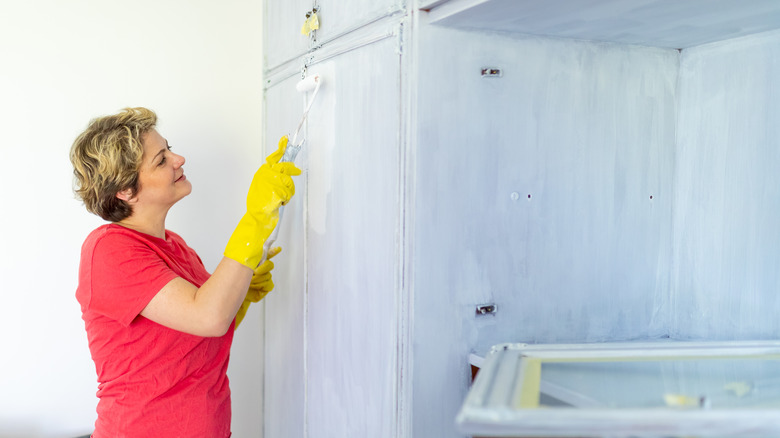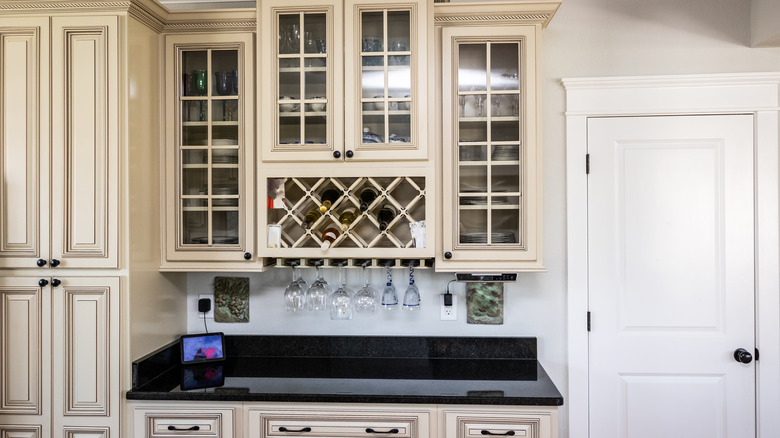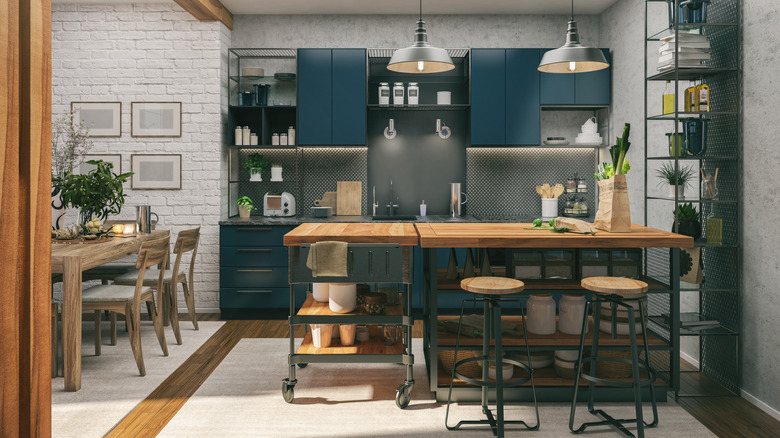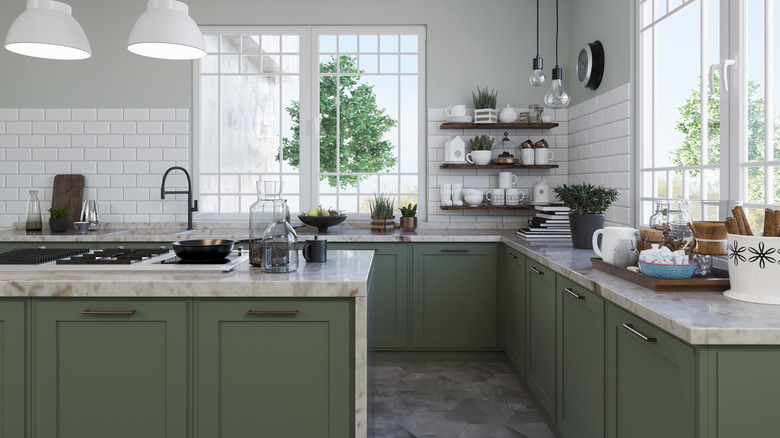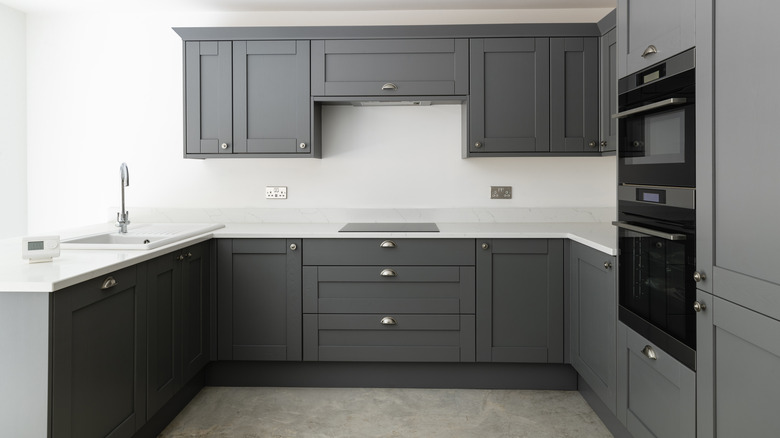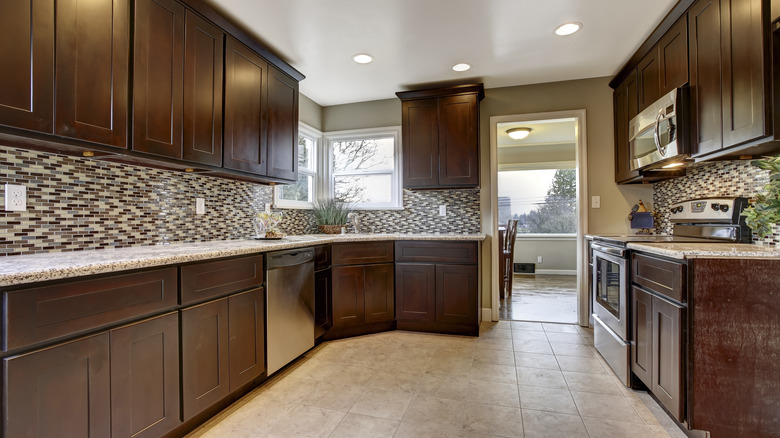These Cabinet Colors Are The Best For Hiding Dirt And Grime In Your Kitchen
Kitchen cabinet stains and paint colors can be one of the most dramatic and visible elements of any kitchen. Whether your cabinets are limited in number or span entire portions of the space, those large swathes of color and tone are sometimes the first thing you see when entering a room. This makes it important to get them right, not only for their aesthetic impact in collaboration with countertops, flooring, and appliances but also in how you use your kitchen. Our kitchen cabinets often bear the brunt of dirty fingerprints, splatters, grease build-up, and other dirt that can make your cabinets look less than attractive. There are ways, however, to combat that with the colors and stains you choose for them that can both hide and deter dirt or fingerprints, including darker and deeper shades of paint.
The type of paint finish (matte, semi-gloss, high gloss) can also have a huge impact on how easy it is to keep clean, particularly with colors like white and black at either end of the color spectrum. If you are thinking of painting or refinishing existing cabinets, choosing the best kitchen cabinet colors can help keep your kitchen looking as fresh and beautiful as the day it was painted.
Off-white cabinets are more forgiving than bright whites
While trends overwhelmingly favor the white kitchen designs that will never go out of style for their bright demeanor and classic adaptability, it can actually be one of the hardest colors to keep clean in a kitchen, mainly if you use a matte finish paint, which is likely to show every scuff, smudge, fingerprint, and imperfection on your cabinets. If you love the idea of a light, bright, and airy kitchen with lighter cabinetry, consider using an off-white with a gray or tan cast in a satin or semi-gloss finish. The reflecting light will disguise many kinds of marks and will be easier to wipe down thoroughly.
If you are sold on bright, true-white cabinets, try a two-toned approach. Upper cabinets take on less dirt than lower ones, so use a lighter color up top and a darker, richer complimentary one on the bottom, like dark gray. Great off-white paint shades for cabinets include Sherwin Williams' Aesthetic White or Benjamin Moore's Ballet White.
Deep blue cabinet colors are trendy and easier to clean
One of the hottest colors for kitchen cabinets in the past few years has been blue, particularly deep slate blues, midnight blues, and navy shades. A natural color that some consider most neutral in its amenable relation to other shades, blue is a great way to add a pop of color to your kitchen and create a calming, relaxing feel. The darkest shades are also a great alternative to installing black kitchen cabinets, which can be some of the trickiest ones to keep clean. Dark blue, particularly in a semi-gloss finish, displays similar drama and depth without showing every little dirt.
Blue is a popular color among cottage and farmhouse interiors, but it can also look sleek and contemporary with a more modern cabinet design. Blue also looks beautiful with high-contrast white counters, silver appliances, and natural wood accents. Great blues for cabinets include Farrow & Ball's High Wych, Behr's Blue All Over or Cataline Coast, or Benjamin Moore's Hale Navy.
Dark green cabinets feel natural and hide grime
Joining blue as an almost-neutral green is excellent if you are looking for a color that evokes a feeling of nature and freshness. Perfect shades for battling dirt and grime include medium greens like deeper sages, dark olive greens, and hunter greens. These colors disguise marks and fingerprints well and can be as dark and dramatic as black. Green is also known for granting a sense of relaxation and earthiness to kitchens that complement a place where people want to gather.
Like blue, green is amenable to many other complementary colors and textures and works well with a variety of aesthetics, including vintage-inspired, boho, and farmhouse kitchens. While the darkest shades can be less ideal in a kitchen that lacks proper light, you can drift toward the lighter end of the spectrum if you want something brighter. Some perfect greens for cabinets include Benjamin Moore's Rosemary Sprig, Behr's Secret Meadow, and Farrow & Ball's Bancha.
Gray cabinet colors can work for any design
Gray is one of those colors that seems to have endless variations, ranging from the palest dove grays to deep charcoals that almost look black. Multiple tones, including underlying blues, creams, and greens, make each gray unique. If you love lighter cabinets, a pale gray makes a great alternative to white or off-white, reflecting a light and airy feel while not showing every little mark. Darker, deeper grays can be cozy and dramatic all at once and set a great neutral background that complements a variety of design aesthetics.
If you plan to redecorate in the future or sell your home, gray may be your best choice since you can skew it in a variety of design directions and color palettes more than any other color other than simple black and white. Try a warmer gray shade in collaboration with brass accents or a cooler one with stainless steel. Great grays for the kitchen include Benjamin Moore's Stormy Monday or Sherwin Williams' Dorian Gray.
Espresso brown cabinets are timeless and disguise dirt
Another great alternative to black, deep browns are a fun choice if you're looking for shades that do not show marks or dirt. They are also likely to disguise stains from splatters like coffee or wine more readily. Painted brown cabinets in shades of chocolate and espresso work well, as do deeper stained woods like dark chestnut and mahogany. These wood finishes, however, can also be likely to show more noticeable scratches and digs than a lighter wood stain, so keep this in mind if you have children or pets or if the cabinets are in a high-traffic area.
If deep brown feels a bit too dark in your kitchen, try going for medium wood stains like oak or walnut. These woods give the depth and dimension of darker woods but still reflect a lot of light. Cabinets with more prominent wood grain are better for disguising fingerprints or marks than less-grained wood.
